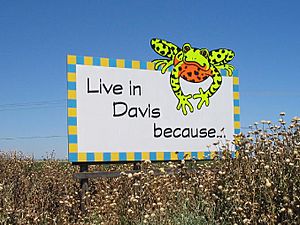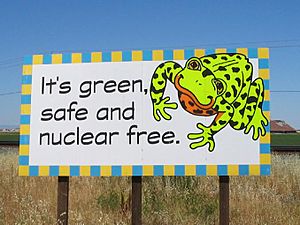Anti-nuclear movement in California facts for kids
The 1970s was a very important time for the anti-nuclear movement in California. During this period, there were many disagreements between people who supported nuclear power and those who wanted to protect the environment. For example, in 1981, about 1,900 activists were arrested while protesting at the Diablo Canyon Power Plant. Later, in 1984, the City of Davis declared itself a "nuclear-free zone." California has also stopped approving new nuclear reactors since the late 1970s because of worries about how to safely get rid of nuclear waste.
Contents
California's First Nuclear Power Fights
The anti-nuclear movement in California began with a big disagreement. This was about Pacific Gas & Electric's plan to build the first nuclear power plant in the United States at Bodega Bay. This conflict started in 1958 and ended in 1964. The company had to give up its plans. Later, plans to build another nuclear power plant in Malibu were also stopped.
Growing Concerns in the 1970s
The anti-nuclear movement in California grew a lot between 1964 and 1974. During this time, some scientists and engineers started to agree with the activists. They were influenced by ideas about protecting nature.
Even though Californian voters did not approve a plan in 1972 to stop building nuclear plants for five years, anti-nuclear groups kept fighting. They worked to stop several proposed plants in the 1970s. These were often plants planned for the coast or near earthquake fault lines. One example was the Sundesert Nuclear Power Plant, which was never built.
Big Protests at Diablo Canyon
Over two weeks in 1981, 1,900 activists were arrested at the Diablo Canyon Power Plant. This was the largest number of arrests in the history of the U.S. anti-nuclear movement.
There were also disagreements within the Sierra Club about how to lead the anti-nuclear movement. This led to a split over the Diablo Canyon plant, which eventually helped the power companies. This split also led to the creation of Friends of the Earth, a new environmental group led by David Brower.
In 1979, members of the Abalone Alliance held a 38-day sit-in at California Governor Jerry Brown's office. They were protesting the continued operation of the Rancho Seco Nuclear Generating Station. This plant was similar to the one involved in the Three Mile Island accident. In 1989, voters in Sacramento decided to shut down the Rancho Seco power plant.
California has not approved new nuclear reactors since the late 1970s. This is because of serious concerns about how to safely store nuclear waste.
Cities Declaring Themselves Nuclear-Free

On November 14, 1984, the City Council in Davis, California, declared the city a "nuclear-free zone." Another well-known nuclear-free community is Berkeley, California. Its citizens passed the Nuclear Free Berkeley Act in 1986. This law allows the city to fine groups involved in nuclear weapons activities and to avoid doing business with companies linked to the U.S. nuclear system.
See Also
- Anti-nuclear movement in the United States
- List of anti-nuclear protests in the United States
- Nuclear debate
- Nuclear free zone
- Ondaatje, Elizabeth H. (c1988). Trends in antinuclear protests in the United States, 1984-1987.
- Wellock, Thomas R. (1998). Critical Masses: Opposition to Nuclear Power in California, 1958-1978.
- Wills, John (2006). Conservation Fallout: Nuclear Protest at Diablo Canyon.


